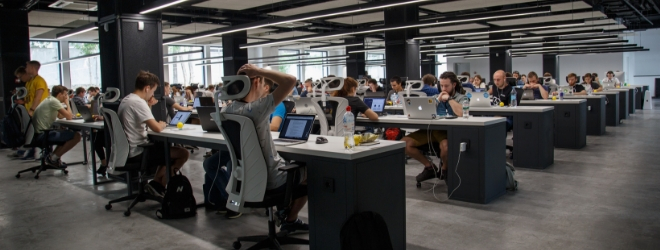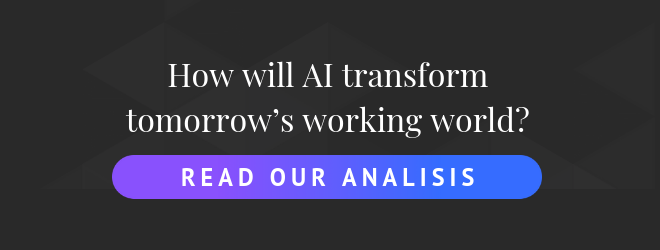With the increasing importance of AI in the economy, a new working world is emerging, marked by a new normal between man and machine.
It all began with a study published in 2013 by two researchers from Oxford University entitled “The future of employment: how susceptible are jobs to computerization?” The study makes an alarming observation: nearly half (47%) of American jobs would be at risk of being automated over the next two decades. Since then, reports on the subject have followed one another, some reaching the same or even more worrying conclusions (a McKinsey study published in 2017 indicates that 50% of the tasks performed in the world are already likely to be automated), others more moderate (such as the study by an American think tank claiming that more on 25% of jobs at risk). These concerns have been widely reported by the media, and television studios have capitalized on the trend, with sci-fi series like Trepalium. But to understand how artificial intelligence will reshape the world of work, one shouldn’t be satisfied with simple numbers.
Robots create jobs
Firstly, though the Oxford University study published in 2013 has largely contributed to launching the debate on robotization, the concerns that machines will replace man are in fact much older. History is full of stories illustrating this phenomenon. When the very first illustrated books were printed in the city of Augsburg at the turn of the 15th century in present-day Germany, local wood engravers, fearing job loss, started a riot and seized the printing works to stop their operation. But the engravers’ concerns soon subsided as more and more people came to seek their services. As the printing house had drastically reduced the price of books, demand increased, so it was necessary to increase the supply of illustrated books and to use wood engravers to produce the original illustrations. It is a classic mechanism in economics, also observed in the 19th century, with the invention of the loom, which made it possible to increase productivity and thus lower the cost of clothing, leading to an increase in demand for the latter, with more work for weavers.
Of course, innovation also regularly destroys jobs. The mechanical mower has made the mower’s job obsolete. But, according to the creative destruction theorized by the Austrian economist Joseph Aloïs Schumpeter, it also creates new ones. It takes engineers to design mechanical mowers, workers to build and maintain them, etc. The question cannot therefore be limited to the number of jobs that AI will destroy: we must also consider those it will create. While it is equally difficult to predict one or the other, it is generally estimated that automation will create more jobs than it will destroy.

Some already observable phenomena support this idea. Let’s take the example of Amazon, a company that is a champion of robotization. The American multinational relies on drones to deliver its packages, has deployed robots to move packages in its warehouses, and invested in an automated cash register system. In 2016, the number of robots operated by Amazon was estimated at 45,000, up 50% from 2015. However, this forced-running robotization has not been accompanied by a wave of redundancies, quite the contrary: From 2015 to 2016, Amazon’s workforce also increased by 50%. Robotization hasn’t put pressure on wages either, as Amazon increased the minimum wage distributed to employees last year. Elon Musk, who had relied on the unbridled automation of his factories to produce his Tesla Model 3, quickly found himself forced to increase his workforce drastically to run all these machines. This logic is reflected at the macroeconomic level: countries with the highest number of robots per worker, such as South Korea, Japan and Germany, all have very low unemployment rates.
Man and machine are often complementary
Let us assume that in quantitative terms, AI and robotics allow for net job creation. There remains a frequently used argument to point out the risks of this technology, which is more focused on the qualitative aspect. Of course, new jobs will compensate for the disappearance of the former, but the qualifications required to fill them will not be the same. The jobs most at risk from AI would be those that require few qualifications: cashiers put out of work by automatic cash registers, call center employees threatened by artificial speech intelligences, such as the one presented by Google at its last Google I/O summit, delivery workers replaced by delivery robots… In return, the jobs created would mainly be jobs in engineering, requiring high qualifications: data scientists, AI experts, robotics engineers, etc. It is unlikely that a cashier who was dismissed the day before could convert the next day into a Big Data specialist.
But things are actually much more complex. Indeed, however impressive the AI’s capabilities may be, it is still far from being perfectly autonomous. In most cases, a job won’t be entirely performed by a human being because only certain specific tasks will be automated. Rather than thinking in terms of jobs, one must think in terms of tasks. To take a frequently mentioned example, it is possible that an artificial intelligence may one day be able to decipher medical x-rays more effectively than a professional radiologist (although probably not as quickly as one would think). But once this step is completed, it will be up to the doctor to validate the diagnosis, choose the right treatment, talk with the patient and accompany them during their treatment. Similarly, if a robot can deliver pizzas, it takes a human to take orders, put the pizza in its box, give it to the robot, process customer requests, put the robot away at the end of the day, etc. However, many of these tasks that AI is unable to perform do not necessarily require a high level of qualification, but rather versatility, a sense of human contact, social skills, etc. They are therefore accessible to unskilled workers.
The rise of “micro-tasks”
Another consequence of this automation of certain activities by machines is the creation of a whole new online work ecosystem, with companies recruiting human workers to perform complementary micro tasks with AI. Perhaps one of the most famous examples is Amazon’s Mechanical Turk, which allows companies to recruit temporary workers to perform small missions that computers are unable to perform, called “human intelligence tasks”. This can involve writing product description sheets, transcribing small pieces of audio files, or describing the content of an image. In 2017, the platform had about 500,000 “turkers”. Many new technology companies also use external workers to carry out small assignments of this kind. Google employs several thousand people to ensure that videos posted on YouTube comply with the rules in force on the platform. Microsoft, for its part, has adopted a Universal Human Relevance System, which distributes millions of micro tasks to digital workers every month. This may include, for example, checking the relevance of Internet Explorer’s search algorithms. For its part, Facebook uses the services of 30,000 moderators to monitor the content published on the platform.

All these examples show how complementary artificial and human intelligence are. All these companies that are at the forefront of AI research have an increasing need for manpower to perform all these additional tasks that algorithms cannot handle. Take the case of autonomous cars. In order for them to be able to decipher traffic signs and distinguish a cyclist from a pedestrian, their software must be fed with large quantities of videos illustrating these different types of situations. But these videos must first be labelled by humans so that the machines can understand them (the video must for example be accompanied by a description specifying that this is a pedestrian, a cyclist, etc.). Once the algorithm has been trained and deployed, the role of humans does not end: they must now ensure that it works properly and provide opportunities for improvement.
It is therefore likely that platforms such as Amazon Mechanical Turk or Upwork are the first signs of what part of the labor market might look like in the future: human labor fragmented into different tasks, likely to be ordered and performed online, and combined with activities performed by AI. Michael Bernstein and Melissa Valentine, researchers at Stanford University, even imagine the growth of temporary digital companies, mixing AI and digital workers, that would be dedicated to fulfilling a specific mission, for example building an application that converts audio and video files into written text for the deaf and hard of hearing.
This tomorrow’s working world will certainly not be marked by mass unemployment. On the other hand, it will require workers to be highly flexible and versatile, to be able to perform many different tasks and to regularly update their skills. It is therefore imperative to adapt education to facilitate training for this workforce of tomorrow. And as Dr. Laurent Alexandre suggests, teaching reading, history, philosophy, all those activities that help us learn to think, to improve the elasticity of the brain, could be much more important than learning to code.

